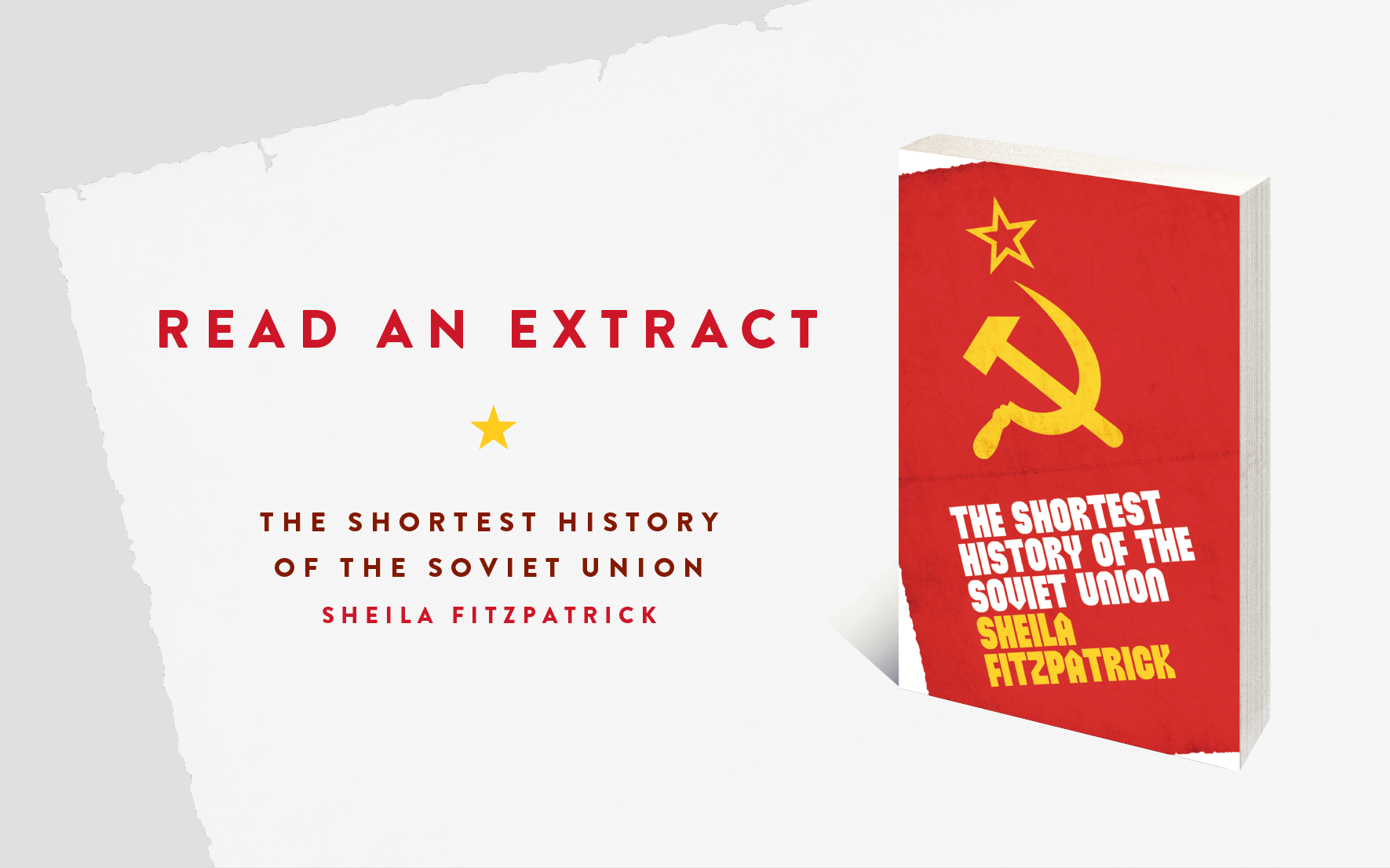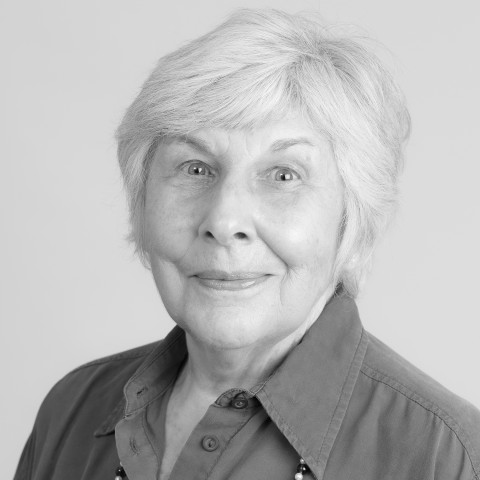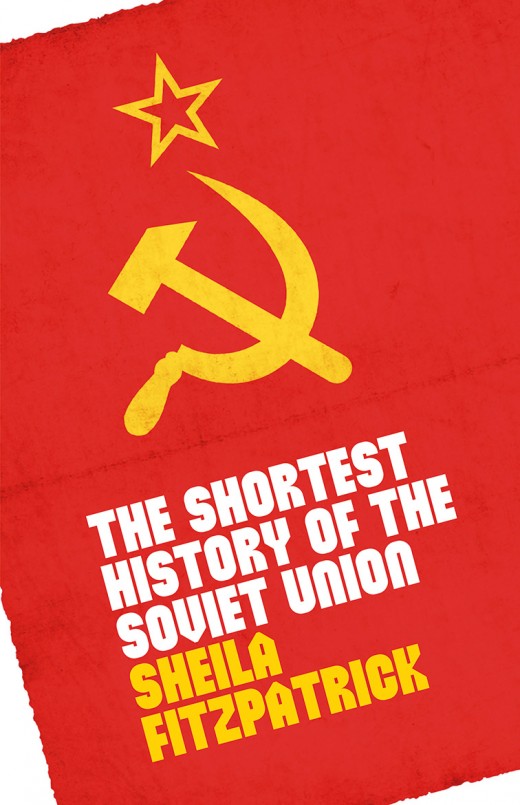News

News > Extract
Read an extract: The Shortest History of the Soviet Union
It began with a revolution and a dream to build a better society. By 1991, the hammer and sickle had fallen. Now, as we watch with horror as the events unfold in the Ukraine, a move spurned by Putin's authoritarian desire to restore Russia’s influence to the days of the Soviet Union, Sheila Fitzpatrick's The Shortest History of the Soviet Union provides detailed context to the history of the region. This is the is story of an empire made and an empire undone.
1980 should have been a good year for the Soviet Union. Finally, fifty-eight years after the creation of the Soviet Union and entering the sixteenth year of Leonid Brezhnev’s boring but stable leadership, the country could relax and feel that the worst was behind it. Domestically, normality had been achieved; better times must lie ahead. Internationally, the country had become a superpower after World War II, admittedly still number two to the United States, but now at last reaching military parity.
It had been a bumpy ride – a revolution and civil war to start off with, famine in 1921 and revolutionary leader Vladimir Lenin’s early death in 1924. Then came a new upheaval, launched at the end of the 1920s by Lenin’s successor, Joseph Stalin, involving forced-pace industrialisation and collectivisation of peasant agriculture, with famine in 1932–1933 as the aftermath. The extraordinary bloodshed of the Great Purges in 1937–1938 came next, hitting Communist elites particularly hard, followed quickly by World War II, when the erstwhile pariah state became an ally of the West. With the war’s end and hard-won victory came the Soviet Union’s unexpected, sudden rise to superpower status in a context of Cold War with the West. Nikita Khrushchev, emerging as top man after Stalin’s death in 1953, was a pursuer of ‘harebrained schemes’ who seemed to bring the nation to the verge of war again in the Cuban missile crisis of 1961 before he was toppled in 1964.
And then, finally, Leonid Brezhnev took the helm, the stolid, genial man who didn’t rock the boat but directed it into calmer seas, understanding the aspiration of Soviet citizens for a lifestyle closer to that of the United States and Western Europe. Brezhnev’s task was made easier by an unexpected bonus: as of 1980, the world price of oil (of which the Soviet Union had become a major producer and exporter in recent decades) had doubled since the mid-1970s and stood at an all-time high.
Khrushchev had rashly promised that the country would achieve full communism by 1980. The more cautious Brezhnev shelved this in favour of ‘developed socialism’, an anodyne formulation that stood, in effect, for the economic and political system that already existed in the Soviet Union. But that was fine by the majority of Soviet citizens. They wanted more consumer goods for themselves, not communally shared goods, as would be delivered under the Communist model. It was a post-revolutionary moment, with the Revolution firmly consigned to history. The generation that had fought for it was now dead or pensioned off, and even the cohort (including Brezhnev) that rose as its beneficiaries under Stalin was approaching retirement. Brezhnev’s own values in later life were more aligned with those the revolutionaries used to call ‘bourgeois’ than those his predecessors had espoused. (A joke widely circulated at the time had Brezhnev’s mother asking anxiously about his personal collection of expensive Western cars: ‘But Lenya, what if the Bolsheviks come back?’)
Living standards were up; a previously acute housing shortage had been ameliorated; no national or social groups were threatening revolt. The 1977 Constitution, affirming the success of the building of socialism in the Soviet Union, claimed that ‘a new historical community of people, the Soviet people,’ had come into being. To be sure, the Soviet Union still had problems: a slowing economy; an unwieldy bureaucracy showing little desire or capacity for reform; periodic outbursts of discontent with Soviet tutelage in Eastern Europe; difficulties with the United States and ‘détente’; and in the Soviet Union itself, the emergence of a small ‘dissident’ movement with little support in the wider population but close ties with Western journalists. After Soviet troops went into Afghanistan on 24 December 1979, an international boycott campaign tarnished the Summer Olympics that proudly opened in Moscow in July 1980.
The West had made a totalitarian bogeyman out of the Soviet Union during the Cold War, equating Communism with Nazism as the antithesis of Western democracy, and one of the tenets of this theory was that a totalitarian regime, once in place, was immutable and could be overthrown only by external force. But that idea seemed less plausible when, after Stalin’s death, the regime not only failed to collapse but also showed itself capable of radical change. By 1980, ‘totalitarianism’, although remaining a powerful and emotive image for the Western public, had lost its appeal for scholars, American political scientists Stephen F. Cohen and Jerry Hough being among its challengers. Even in conservative quarters, hopes that had been cherished for more than sixty years about the imminent collapse of the Soviet regime were being quietly abandoned.
Summing up the consensus at a conference of mainstream American Sovietologists, Robert Byrnes noted that ‘all of us agree that there is no likelihood whatsoever that the Soviet Union will become a political democracy or that it will collapse in the foreseeable future’ (my emphasis). An important text of US Sovietology, published by political scientist Seweryn Bialer in 1980, argued that it was time for the United States to give up vain hopes of regime change and accept that the Soviet Union was there to stay. In a similar spirit, the Library of Congress in Washington, DC, finally decided – after decades of ignoring the existence of the Soviet Union in response to émigré and Cold War pressure – to bite the bullet and give the Soviet Union its own entry in the library’s card catalogue. This was an eminently reasonable move and, as virtually everyone in the Soviet research community agreed, long overdue. But in practice the library might have saved itself the trouble. Within a decade, as it turned out, there would be no Soviet Union to catalogue.
SHORTEST HISTORY (1924–1991)
When I first encountered the Soviet Union as a graduate student, just before the fiftieth anniversary of the October Revolution, I would not have expected to have been one of the scholars writing its obituary on what would have been its hundredth birthday. Its life span turned out to fall short of the statutory seventy – just a few years longer than the life expectancy of Soviet citizens born at the end of the Soviet era (sixty-seven), which was almost twice the life expectancy of those born at its beginning.
Historians’ narratives tend, by their nature, to make events seem inevitable. The better the explanation, the more the reader is made to feel that there could have been no other outcome. But this is not my intention with this Shortest History. My view is that there are as few inevitabilities in human history as there are in the individual lives that compose it. Things could always have turned out differently but for accidental encounters and global cataclysms, deaths, divorces and pandemics. In the Soviet case, to be sure, we are dealing with revolutionaries who, following Marx, thought they had history taped and knew, in broad outline, what to expect at any given historical stage. ‘Accidentally’ (sluchaino) and ‘spontaneously’ (stikhiino) were always pejorative terms in Soviet usage, denoting things that, according to the Plan, were not supposed to happen; they were also among the commonest words in the Soviet lexicon. These same Marxist revolutionaries, dedicated to the notion of subordinating the natural and economic environment to human planning, came to power in October 1917 to their own surprise and, in defiance of their theoretical analysis of the situation, almost accidentally.
Ironies abound in the Soviet history I am about to tell, and surely this is partly a result of the revolutionaries’ conviction that in Marxism they had a universal decoding tool. It told them, for example, that societies were divided into antagonistic classes, each with their own political representatives, and that their party – initially the Bolshevik faction of the Russian Social Democratic Labour Party, and from 1918 the Communist Party – represented the proletariat. This was sometimes accurate and sometimes not, depending on the circumstances, but in any case it became increasingly irrelevant: after the party took power, it soon became clear that the party’s main function vis-a-vis the workers and peasants who supported them was to offer the opportunity for upward mobility (a process not recognised in Marxist theory).
Theory told the Bolsheviks that the new multinational Soviet state was a totally different animal from the old multinational Russian Empire, despite the substantial coincidence of their borders, and that its centre could not practise imperialist exploitation of its peripheries because, by definition, imperialism was ‘the highest stage of capitalism’ and completely alien to socialism. As we shall see, this was a more reasonable proposition, particularly in the early decades, than it might seem at first glance; on the other hand, it’s not hard to see why people in non-Slavic regions on the periphery could sometimes feel that being under the eye of Soviet Moscow was not totally unlike being under the eye of tsarist St Petersburg.
The Western view of the Soviet system as ‘totalitarian’ was not meant to be flattering. But actually, from the Soviet standpoint, it could almost be seen as a compliment, being a mirror image of the Communist Party’s own self-image as the all-knowing leader, setting a steady course on the basis of science and planning, with everything down to the last detail under control. The many ‘accidental’ changes of course and ‘spontaneous’ diversions along the way were simply irrelevant to this grand scheme, although they will play a large part in my Shortest History. They were not irrelevant to the life of people living in the Soviet Union, of course, and the gap between official rhetoric and lived experience was the stuff of the distinctively Soviet genre of political jokes (anekdoty) that bubbled under the surface as a constant, irreverent commentary. The contrast between ‘in principle’ (a stock Soviet phrase provoking immediate distrust, like ‘frankly’ in the West) and ‘in practice’ was one of the staples of the Soviet anekdot. Another was the Marxist concept of dialectics, which held that socio-economic phenomena, such as capitalism, contained within themselves their own opposites (socialism, in the case of capitalism). Dialetika, a foreign word, was a philosophical concept adopted from Hegel, but the prevalence of mandatory ‘political literacy’ classes meant that most Soviet citizens were familiar with its remarkable capacity to explain away apparent contradictions. The quintessential Soviet dialectical joke was this antiphonal formulation:
(Question) What is the difference between capitalism and socialism?
(Answer) Capitalism is the exploitation of man by man, and socialism is its replacement by its opposite.
The Marxist prediction that capitalism would ultimately collapse and be replaced by socialism (Khrushchev’s tactless ‘We will bury you!’) had been a comfort to Soviet Communists as they struggled against Russia’s historical ‘backwardness’ to make a modern, industrialised, urbanised society. They made it, more or less, by the beginning of the 1980s. Soviet power and status was recognised throughout the world. ‘Soviet man’ became a recognisable animal, with close relatives in the Soviet bloc in Eastern Europe, more problematic relatives in China and North Korea, and admirers in the Third World.
Then, in one of the most spectacular unpredicted ‘accidents’ of modern history, it was Soviet ‘socialism’ that collapsed, giving way to what the Russians called the ‘wild capitalism’ of the 1990s. An array of fifteen new successor states, including the Russian Federation, emerged blinking into the light of freedom – all, including the Russians, loudly complaining that in the old days of the Soviet Union they had been victims of exploitation. What Was Socialism, and What Comes Next? was the apt title of American anthropologist Katherine Verdery’s commentary on the post-Soviet moment, pointing to the fact that in the former Soviet bloc it was not only the future that had suddenly become unknowable but also the past. ‘What comes next?’ is a question no prudent historian ever tries to answer. As for ‘What was socialism?’, that can be addressed by political philosophers with reference to canonical texts, but I will take a different tack – that of the historical anthropologist. Whatever socialism might mean in principle, something that in the 1980s earned the clumsy name of ‘really existing socialism’ emerged in practice in the Soviet Union. This is its story, from birth to death.
This is an extract from The Shortest History of the Soviet Union by Sheila Fitzpatrick. To read more, order The Shortest History of the Soviet Union – out now.
Share this post
About the author
Sheila Fitzpatrick is a pioneer in the field of Soviet history. She regularly contributes to the London Review of Books and is the multi-award-winning author of many books, including Everyday Stalinism, On Stalin's Team, The Russian Revolution, White Russians, Red Peril and the bestselling The Shortest History of the Soviet Union.
More about Sheila Fitzpatrick




